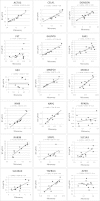Global gene expression in endometrium of high and low fertility heifers during the mid-luteal phase of the estrous cycle
- PMID: 24669966
- PMCID: PMC3986929
- DOI: 10.1186/1471-2164-15-234
Global gene expression in endometrium of high and low fertility heifers during the mid-luteal phase of the estrous cycle
Abstract
Background: In both beef and dairy cattle, the majority of early embryo loss occurs within the first 14 days following insemination. During this time-period, embryos are completely dependent on their maternal uterine environment for development, growth and ultimately survival, therefore an optimum uterine environment is critical to their survival. The objective of this study was to investigate whether differences in endometrial gene expression during the mid-luteal phase of the estrous cycle exist between crossbred beef heifers ranked as either high (HF) or low fertility (LF) (following four rounds of artificial insemination (AI)) using the Affymetrix® 23 K Bovine Gene Chip.
Results: Conception rates for each of the four rounds of AI were within a normal range: 70-73.3%. Microarray analysis of endometrial tissue collected on day 7 of the estrous cycle detected 419 differentially expressed genes (DEG) between HF (n = 6) and LF (n = 6) animals. The main gene pathways affected were, cellular growth and proliferation, angiogenesis, lipid metabolism, cellular and tissue morphology and development, inflammation and metabolic exchange. DEG included, FST, SLC45A2, MMP19, FADS1 and GALNT6.
Conclusions: This study highlights, some of the molecular mechanisms potentially controlling uterine endometrial function during the mid-luteal phase of the estrous cycle, which may contribute to uterine endometrial mediated impaired fertility in cattle. Differentially expressed genes are potential candidate genes for the identification of genetic variation influencing cow fertility, which may be incorporated into future breeding programmes.
Figures





Similar articles
-
Endometrial gene expression in high- and low-fertility heifers in the late luteal phase of the estrous cycle and a comparison with midluteal gene expression.Physiol Genomics. 2016 Apr;48(4):306-19. doi: 10.1152/physiolgenomics.00042.2015. Epub 2016 Feb 5. Physiol Genomics. 2016. PMID: 26850042
-
Differential gene expression profiling of endometrium during the mid-luteal phase of the estrous cycle between a repeat breeder (RB) and non-RB cows.Reprod Biol Endocrinol. 2017 Mar 23;15(1):20. doi: 10.1186/s12958-017-0237-6. Reprod Biol Endocrinol. 2017. PMID: 28335821 Free PMC article.
-
Effects of fertility on gene expression and function of the bovine endometrium.PLoS One. 2013 Aug 5;8(8):e69444. doi: 10.1371/journal.pone.0069444. Print 2013. PLoS One. 2013. PMID: 23940519 Free PMC article.
-
Associations between the manipulation of patterns of follicular development and fertility in cattle.Anim Reprod Sci. 2003 Oct 15;78(3-4):327-44. doi: 10.1016/s0378-4320(03)00098-8. Anim Reprod Sci. 2003. PMID: 12818652 Review.
-
Mechanisms underlying reduced fertility in anovular dairy cows.Theriogenology. 2016 Jul 1;86(1):254-62. doi: 10.1016/j.theriogenology.2016.04.038. Epub 2016 Apr 21. Theriogenology. 2016. PMID: 27160451 Review.
Cited by
-
Secretory Proteomic Responses of Endometrial Epithelial Cells to Trophoblast-Derived Extracellular Vesicles.Int J Mol Sci. 2023 Jul 25;24(15):11924. doi: 10.3390/ijms241511924. Int J Mol Sci. 2023. PMID: 37569298 Free PMC article.
-
Deviations from Mendelian Inheritance on Bovine X-Chromosome Revealing Recombination, Sex-of-Offspring Effects and Fertility-Related Candidate Genes.Genes (Basel). 2022 Dec 9;13(12):2322. doi: 10.3390/genes13122322. Genes (Basel). 2022. PMID: 36553588 Free PMC article.
-
Cervical immune activation during the luteal phase may compromise subsequent trans-cervical ram sperm transport†.Biol Reprod. 2022 Oct 11;107(4):967-976. doi: 10.1093/biolre/ioac130. Biol Reprod. 2022. PMID: 35766421 Free PMC article.
-
A comparative analysis of the intrauterine transcriptome in fertile and subfertile mares using cytobrush sampling.BMC Genomics. 2021 May 22;22(1):377. doi: 10.1186/s12864-021-07701-3. BMC Genomics. 2021. PMID: 34022808 Free PMC article.
-
Impact of hormonal modulation at proestrus on ovarian responses and uterine gene expression of suckled anestrous beef cows.J Anim Sci Biotechnol. 2017 Nov 1;8:79. doi: 10.1186/s40104-017-0211-3. eCollection 2017. J Anim Sci Biotechnol. 2017. PMID: 29118976 Free PMC article.
References
-
- Butler WR, Smith RD. Interrelationships between energy balance and postpartum reproductive function in dairy cattle. J Dairy Sci. 1989;72(3):767–783. - PubMed
-
- Royal M, Mann GE, Flint AP. Strategies for reversing the trend towards subfertility in dairy cattle. Vet J. 2000;160(1):53–60. - PubMed
-
- Royal MD, Darwash AO, Flint APF, Webb R, Woolliams JA, Lamming GE. Declining fertility in dairy cattle: changes in traditional and endocrine parameters of fertility. Anim Sci. 2000;70:487–501.
-
- Dunne LD, Diskin MG, Sreenan JM. Embryo and foetal loss in beef heifers between day 14 of gestation and full term. Anim Reprod Sci. 2000;58(1–2):39–44. - PubMed
-
- Berg DK, van Leeuwen J, Beaumont S, Berg M, Pfeffer PL. Embryo loss in cattle between days 7 and 16 of pregnancy. Theriogenology. 2010;73(2):250–260. - PubMed
Publication types
MeSH terms
Substances
LinkOut - more resources
Full Text Sources
Other Literature Sources
Molecular Biology Databases
Research Materials
Miscellaneous

